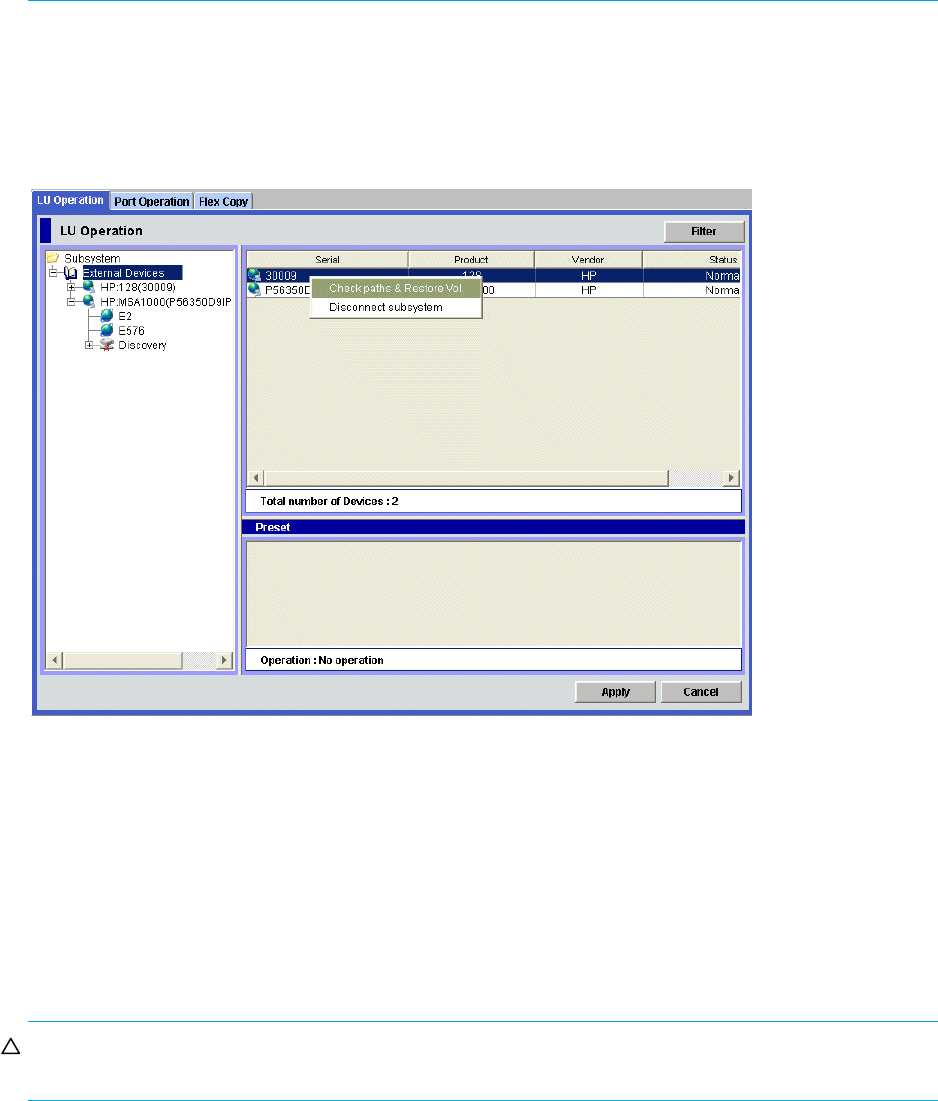HP StorageWorks External Storage XP user guide (T1706-96006, June 2006)
Table Of Contents
- HP StorageWorks External Storage XP user guide
- Contents
- About this guide
- 1 Overview of connecting external arrays
- 2 Preparing for External Storage XP operations
- System requirements
- External Storage XP requirements
- Installing External Storage XP
- Preparing for External Storage XP settings
- Powering arrays on or off
- Using mapped external LUs from the host connected to the local array
- Uninstalling External Storage XP
- Limitations on External Storage XP operations
- Figure 11 Example of external LU with 2 TB or less
- Figure 12 External LU capacity is larger than the specified emulation type’s basic capacity (OPEN-3 example)
- Figure 13 External LU capacity is smaller than the specified emulation type’s basic capacity
- Table 4 When external LU’s emulation type is OPEN
- Table 5 When external LU’s emulation type is for mainframes
- Combining External Storage XP with other HP StorageWorks products
- 3 Managing cache with external storage
- Guidelines for using cache with external storage
- Determining, setting, or changing the external LU cache mode
- Partitioning cache for external storage
- Determining the number and size of needed partitions
- Creating Cache partitions
- Changing storage system modes
- 4 External Storage XP panes
- 5 Configuring external LUs
- Overview of configuring external LUs
- Setting an external array’s port
- Setting a local array’s port attributes
- Mapping external LUs (Add LU)
- Setting alternate paths for external LUs
- Adding alternate paths by selecting multiple external LUs (Add Paths)
- Deleting alternate paths by selecting multiple external LUs (Delete Paths)
- Checking an external LU’s status (LDEV Information)
- Disconnecting external arrays or LUs
- Checking the connection status and resuming external LU operations (Check Paths & Restore Vol.)
- Restoring external LUs (LDEV Restore)
- Stopping the use of paths to an external LU by specifying an external array’s WWN (Disconnect Paths)
- Restoring paths to an external LU by specifying an external array’s WWN (Check Paths)
- Changing an external array’s port setting
- Stopping the use of paths to an external LU by specifying a local array’s port (Disconnect Paths)
- Restoring paths to an external LU by specifying a local array’s port (Check Paths)
- Deleting external LU mappings (Delete LU)
- 6 Troubleshooting NAS Blade systems that include external arrays
- 7 Remote command devices
- 8 Troubleshooting External Storage XP
- A Notes on connecting external arrays
- Connecting Thunder 9500V subsystems
- System parameters for connecting Thunder 9500V subsystems
- Relationship between serial numbers in the Device list on the LU Operation pane and Thunder 9500V subsystem models
- Relationship between the WWN of the port on the Thunder 9500V subsystem and the controller
- Path status and examples of recovery procedures (Thunder 9500V subsystems)
- Connecting TagmaStore AMS and TagmaStore WMS subsystems
- System parameters for connecting TagmaStore AMS and TagmaStore WMS subsystems
- Relationship between serial numbers in the Device list on the LU Operation pane and TagmaStore AMS and TagmaStore WMS subsystem models
- Relationship between the WWN of the port on the TagmaStore AMS or TagmaStore WMS subsystem and the controller
- Path status and examples of recovery procedures (TagmaStore AMS and TagmaStore WMS subsystems)
- Connecting XP12000/XP10000 Disk Arrays
- Connecting XP1024/XP128 Disk Arrays
- Connecting XP512/XP48 Disk Arrays
- Connecting HP 200 Storage Virtualization System as external storage
- Connecting EVA arrays
- Connecting Thunder 9500V subsystems
- B Required volume capacity for emulation types
- C Adjusting volume capacity for copy pair setting
- D Using an XP12000/XP10000/SVS200 with an EVA3000/5000 external storage
- E Configuring MSA1000/1500 as external arrays
- Index

External Storage XP user guide 99
• You cannot execute the Disconnect Subsystem ore Disconnect Volume command for external LUs that
include LDEVs for which Auto LUN XP’s migration processing is in progress.
• When executing the Disconnect Subsystem or Disconnect Volume command, the Ex-Dev. Status column
in the Device list changes to Cache Destage. Even if there is no data left in cache memory, the
displayed status remains as Cache Destage, until the Disconnect Subsystem or Disconnect Volume
command processing is complete.
• When the Disconnect Subsystem or Disconnect Volume command is executed and all data in cache
memory is written to the external LU, the Ex-Dev. Status column in the Device list changes to Disconnect.
Disconnecting all external LUs in an external array (Disconnect Subsystem)
1. In the LU Operation pane, select External Devices in the Device tree. Connected external arrays appear
in the Device list.
2. In the Device list, right-click the external array you want to disconnect from the local array, and select
Disconnect Subsystem.
Figure 58 Disconnect Subsystem and Check Paths & Restore Vol. Commands
The selected external array appears in blue italics in the LU list and Device list, and appears in the
Preset list. To check details of the intended operations, right-click the setting in the Preset list, and select
Detail. To cancel settings, right-click the setting in the Preset list, and select Delete.
3. Click Apply. A confirmation message appears.
4. Click OK.
The Ex-Dev. Status column in the Device list changes to Cache Destaging. When External Storage XP
finishes writing data from cache to the external LU, the Ex-Dev. Status column changes to Disconnect.
If errors occur during disconnect operations, failed settings and error codes appear in the Preset list. To
check error messages, right-click the failed setting, and select Detail.
CAUTION: To access the external array after executing the Disconnect Subsystem command, you must
execute the Check Paths & Restore Vol. command.










